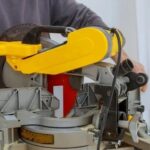When taking on woodworking projects, one of the crucial decisions to make is what kind of nailer to use for the task at hand. The right nailer can greatly impact the outcome of your project, ensuring efficiency, precision, and overall quality. Whether you are working on a small craft project or constructing furniture pieces, selecting the appropriate nail gun is essential.
Using the wrong type of nailer can result in damage to your woodwork or cause inefficiency in completing your project. Understanding the different types of nail guns available for woodworking such as brad nailers, finish nailers, and framing nailers can help you make an informed choice based on your specific needs and preferences.
In this article, we will dive into the world of woodworking nailers, exploring the various types available and providing guidance on how to choose the best one for your projects. From discussing key factors to consider when selecting a nail gun to offering maintenance tips and budget-friendly options, we aim to equip you with all the necessary information to enhance your woodworking experience. So let’s explore what kind of nailer will best suit your woodworking endeavors.
Types of Nailers
When it comes to woodworking projects, choosing the right nailer is essential to ensure that your work turns out as planned. There are several types of nail guns available, each designed for specific purposes and woodworking tasks. One of the most common types is the brad nailer, which is ideal for delicate trim work and attaching thin materials without splitting them. Brad nailers use thin nails, leaving behind minimal visible holes that require less wood putty to conceal.
Another popular choice is the finish nailer, which is perfect for installing baseboards, crown molding, or any other woodworking project that requires a more substantial hold than what a brad nailer can provide. Finish nailers use thicker nails compared to brad nailers and leave behind slightly larger holes that can be easily concealed with wood filler.
Lastly, framing nailers are designed for heavy-duty tasks like framing walls or building decks. These nail guns use larger nails and provide a powerful hold suitable for structural applications in woodworking projects.
In deciding what kind of nailer to use for woodworking, it’s crucial to consider factors such as the type of project you’re working on, the wood you’ll be using, and the finish you desire. Understanding these elements will guide you in selecting the right tool for the job and help achieve professional-looking results in your woodworking endeavors.
| Types of Nail Guns | Best Used For |
|---|---|
| Brad Nailer | Delicate trim work, thin materials |
| Finish Nailer | Baseboards, crown molding, heavier trim work |
| Framing Nailer | Framing walls, building decks |
Choosing the Right Nail Gun
When it comes to woodworking projects, choosing the right nail gun is crucial to ensure precision, efficiency, and a high-quality finish. The type of nail gun you use can significantly impact the outcome of your project, so it’s essential to consider several factors before making a decision on what kind of nailer to use for woodworking.
One of the key considerations is the size of your project – larger projects may require a framing nailer, while smaller or more delicate projects may be better suited for a brad nailer or finish nailer.
Another important factor to keep in mind when selecting a nail gun for woodworking is the type of wood you’ll be working with. Different types of woods have varying densities and hardness levels, which can affect the type and size of nails needed for secure fastening.
For hardwoods like oak or maple, a more powerful nailer like a framing nailer might be necessary, whereas softer woods like pine may work well with a finish nailer. Additionally, considering the desired finish of your project will also impact the choice of nail gun – for finer finishes that require minimal touch-up work, a brad nailer might be the best option.
Beyond project size, wood type, and desired finish, there are other factors to take into account when choosing a nail gun for woodworking tasks. Considerations such as ease of use, ergonomics, weight, and safety features should all play a role in your decision-making process.
Some models offer adjustable depth settings that allow you to control how deep the nails are driven into the wood, while others come with comfortable grips and vibration-reducing technology for improved user experience. Safety features like trigger locks and no-mar tips are also essential aspects to look for in any nail gun you choose for woodworking projects.
| Key Factors When Choosing a Nail Gun | Consideration |
|---|---|
| Project Size | Determines whether you need a brad nailer, finish nailer or framing nailer |
| Type of Wood | Affects the required level of nailing power based on wood density |
| Desired Finish | Influences the choice between different types of nailers based on finishing needs |
Best Nailers for Woodworking
Woodworking projects require precision and accuracy when it comes to joining wood pieces together. Using the right nailer for woodworking tasks can make a significant difference in the quality of your finished project. There are several types of nail guns available, but choosing one specifically designed for woodworking can enhance the overall outcome of your project.
When considering what kind of nailer to use for woodworking, brad nailers, finish nailers, and pinners are among the top recommendations for woodworkers. Here are some key features and benefits of each type:
- Brad Nailer: Ideal for delicate trim work and thin pieces of wood, brad nailers use thinner nails that leave small holes that are easy to conceal.
- Finish Nailer: Suitable for larger trim pieces and finishing touches, finish nailers use thicker nails that provide more holding power for heavier materials.
- Pinner: Perfect for attaching delicate trims without splitting the wood, pinners use even smaller nails than brad nailers and leave virtually invisible holes.
In addition to choosing the right type of nail gun, it is important to consider factors such as project size, type of wood being used, and desired finish. By selecting a nailer that meets your specific woodworking needs, you can achieve professional results with efficiency and ease.
Features to Look For
When it comes to woodworking projects, using the right nailer can make a significant difference in the outcome of your work. One of the most crucial aspects to consider when choosing a nail gun for woodworking is the features it offers. Here are some essential features to look for in a nailer:
- Adjustable Depth Settings: A nailer with adjustable depth settings allows you to control how deep the nails are driven into the wood. This feature is particularly useful when working with different types of wood or when you want to avoid overdriving or underdriving nails.
- Ergonomic Design: A comfortable grip and lightweight design are essential features to look for in a nail gun, especially if you have large woodworking projects that require extended use. An ergonomic design can help reduce fatigue and strain on your hands and arms.
- Safety Features: Safety should always be a top priority when working with power tools like nail guns. Look for nailers with safety mechanisms such as trigger locks, no-mar tips to prevent surface damage, and anti-jam features to keep your workflow smooth and safe.
By paying attention to these key features in a nail gun, you can ensure that your woodworking projects are not only done efficiently but also safely. Whether you are a beginner or experienced woodworker, choosing a nailer with adjustable depth settings, ergonomic design, and safety features will enhance your overall woodworking experience.
Nail Gun Tips and Techniques
Nail guns are indispensable tools for woodworking projects, making the task of securing pieces together much faster and more efficient. However, using a nail gun requires proper technique and safety precautions to ensure smooth and safe operation. Whether you are a beginner or an experienced woodworker, these tips and techniques will help you maximize the effectiveness of your nail gun while keeping yourself protected.
Adjusting Depth Settings
One of the most important features to pay attention to when using a nail gun for woodworking is the depth settings. Make sure to adjust the depth according to the thickness of the wood you are working with. Setting it too shallow may not secure the pieces properly, while setting it too deep can cause damage to the surface of the wood. Test on scrap pieces first before starting your project to ensure the settings are correct.
Proper Handling
When operating a nail gun, always hold it firmly with both hands and avoid pointing it towards any part of your body or other individuals. Keep your finger off the trigger until you are ready to shoot nails, and never carry or transport a nail gun with your finger on the trigger. Additionally, make sure there are no obstructions or obstacles in your work area that could interfere with your nailing process.
Safety Gear
Wearing appropriate safety gear is crucial when using a nail gun for woodworking projects. Always wear safety goggles to protect your eyes from flying debris, as well as ear protection if necessary due to loud noise created by the tool. It is also advisable to wear gloves to protect your hands from splinters or any other potential injuries during nailing. By following these safety measures, you can enjoy working with a nail gun safely and effectively on your woodworking projects.
Maintenance and Care
Cleaning and Lubrication
One of the most important aspects of maintaining a nail gun for woodworking is keeping it clean and properly lubricated. Sawdust and other debris can accumulate in the nailer over time, which can affect its performance. Regularly cleaning the nail gun with compressed air or a soft brush can help prevent clogs and jams. Additionally, applying a few drops of oil to the moving parts of the nailer will ensure smooth operation and prolong its lifespan.
Inspecting for Wear and Tear
It is essential to regularly inspect your nail gun for any signs of wear and tear. Check the trigger mechanism, depth adjustment settings, and driver blade for any damages or malfunctions. Replace any worn out or damaged parts immediately to prevent further problems down the line. Keeping an eye on the condition of your nailer will help you identify issues early on and address them before they escalate.
Storing Properly
Proper storage is crucial in extending the lifespan of your nail gun. When not in use, make sure to store the nailer in a dry place away from excess moisture or extreme temperatures. Hanging the tool on a pegboard or storing it in a protective case can also prevent damage during transport or when not in use. By storing your nail gun correctly, you will maintain its performance and functionality for years to come.
By following these maintenance and care tips for your nailer used in woodworking projects, you can ensure that your tool remains in top condition and continues to deliver excellent results. Taking the time to clean, inspect, and store your nail gun properly will not only prolong its lifespan but also enhance the quality of your woodworking projects. Remember that proper maintenance is key in getting the most out of what kind of nailer to use for woodworking tasks.
Budget-Friendly Options
When it comes to woodworking, having the right nail gun can make a significant difference in the outcome of your projects. However, finding a high-quality nailer that fits within your budget can sometimes be a challenge. Luckily, there are several budget-friendly options available that are still reliable and suitable for woodworking tasks.
One cost-effective option for woodworking projects is the brad nailer. Brad nailers are ideal for smaller wood projects and delicate trim work. They use thin nails that leave minimal visible holes, making them perfect for finish carpentry. Despite their smaller size, brad nailers can still provide ample holding power for most woodworking applications.
Another affordable choice for woodworking enthusiasts is the pneumatic finish nailer. Finish nailers are versatile tools that can handle a variety of tasks, such as installing molding, baseboards, and cabinets. These nail guns use slightly larger nails than brad nailers but still offer a clean finish thanks to their narrow gauge nails. With proper adjustment settings, a pneumatic finish nailer can be utilized on different types of wood without causing splitting or damage.
For those looking to invest in a reliable yet budget-friendly option, consider the cordless brad nailer. Cordless nail guns provide convenient portability and freedom of movement without being tethered to an air compressor or power outlet.
While these may come at a slightly higher price point compared to pneumatic models, cordless brad nailers are still an excellent option for woodworking enthusiasts seeking versatility and ease of use in their projects. Remember to assess your specific needs and preferences when choosing what kind of nailer to use for woodworking efficiency and effectiveness in your projects.
Conclusion
In conclusion, selecting the right nailer for woodworking projects is crucial to ensure the quality, efficiency, and safety of your work. With various types of nail guns available in the market – such as brad nailers, finish nailers, and framing nailers – it is essential to consider factors like project size, wood type, and desired finish when making your choice.
Each type of nail gun has its own strengths and limitations, so understanding your specific needs is key to picking the most suitable tool for your woodworking tasks.
When looking for the best nailer for woodworking, it is recommended to choose models that offer essential features like adjustable depth settings, ergonomic design for comfortable operation, and safety features to prevent accidents. These features can enhance your overall experience with the nail gun and contribute to achieving precise and professional results in your woodworking projects. It is important not to overlook proper maintenance and care for your nailer to prolong its lifespan and ensure consistent performance over time.
Whether you are a beginner or an experienced woodworker, investing in a reliable nail gun tailored for woodworking can make a significant difference in the outcome of your projects. By following tips and techniques for using a nail gun effectively and safely, along with exploring budget-friendly options without compromising quality, you can elevate your craftsmanship and efficiency in woodworking.
Remember that choosing the right nailer sets the foundation for successful woodworking ventures – so take the time to assess your needs and find the perfect tool for your next project.
Frequently Asked Questions
What Kind of Nail Gun Do You Use for Woodworking?
The most common type of nail gun used for woodworking is a finish nailer. This tool is versatile and can handle various woodworking projects, from trim work to furniture construction.
Do I Need a Brad Nailer for Woodworking?
While a brad nailer is not a necessity for woodworking, it can be a valuable addition to your toolkit. Brad nailers are ideal for smaller, more delicate trim pieces where you want to minimize the risk of splitting the wood.
Should I Use a Brad Nailer or Finish Nailer for Furniture?
When choosing between a brad nailer or finish nailer for furniture projects, it ultimately depends on the size and type of project you are working on. A brad nailer is better suited for lighter, thinner pieces of wood, such as trim or molding.
On the other hand, a finish nailer is more appropriate for heavier-duty tasks like assembling furniture frames or attaching thicker pieces of wood together. Consider your specific needs to determine which tool would be best for your furniture project.

Hi everyone! I’m a woodworker and blogger, and this is my woodworking blog. In my blog, I share tips and tricks for woodworkers of all skill levels, as well as project ideas that you can try yourself.





